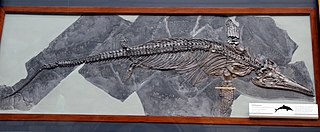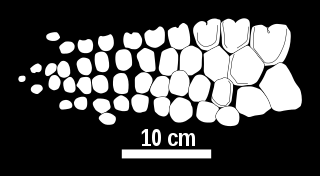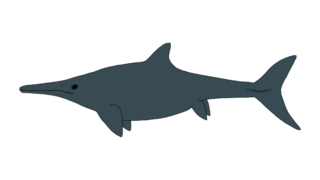
Ichthyosauria is an order of large extinct marine reptiles sometimes referred to as "ichthyosaurs", although the term is also used for wider clades in which the order resides.

Ichthyosaurus is a genus of ichthyosaurs from the Early Jurassic, with possible Late Triassic record, from Europe. It is among the best known ichthyosaur genera, as it is the type genus of the order Ichthyosauria.

Temnodontosaurus is an extinct genus of ichthyosaur from the Early Jurassic period. They lived between 200 and 175 million years ago (Hettangian-Toarcian) in what is now Western Europe and possibly Chile. It lived in the deeper areas of the open ocean. University of Bristol paleontologist Jeremy Martin described the genus Temnodontosaurus as "one of the most ecologically disparate genera of ichthyosaurs," although the number of valid Temnodontosaurus species has varied over the years.

Eurhinosaurus is an extinct genus of ichthyosaur from the Early Jurassic (Toarcian), ranging between 183 and 175 million years. Fossils of the aquatic reptile have been found in Western Europe. They used to live in the deep, open sea area. Eurhinosaurus was a large genus of ichthyosaurs. An adult individual could reach up to 7 metres (23 ft) in length.

Rhomaleosaurus is an extinct genus of Early Jurassic rhomaleosaurid pliosauroid known from Northamptonshire and from Yorkshire of the United Kingdom. It was first named by Harry Seeley in 1874 and the type species is Rhomaleosaurus cramptoni. It was one of the earliest large marine reptile predators which hunted in the seas of Mesozoic era, measuring about 7 metres (23 ft) long. Like other pliosaurs, Rhomaleosaurus fed on ichthyosaurs, ammonites and other plesiosaurs.

Excalibosaurus is a monotypic genus of marine prehistoric reptiles (ichthyosaurs) that lived during the Sinemurian stage of the Early Jurassic period in what is now England. It is characterized by the extreme elongation of the rostrum, with the lower jaw about three-quarters the length of the upper jaw, giving the animal a swordfish-like look. The only known species is Excalibosaurus costini.

Undorosaurus is an extinct genus of ophthalmosaurid ichthyosaur known from western Russia, Svalbard, and Poland. It was a large ichthyosaur, with the type species measuring 4–6 metres (13–20 ft) long.
Mollesaurus is an extinct genus of large ophthalmosaurine ophthalmosaurid ichthyosaur known from northwestern Patagonia of Argentina.

Chacaicosaurus is a genus of neoichthyosaurian ichthyosaur known from the Middle Jurassic of Argentina. The single known specimen of this genus was excavated from the Los Molles Formation in Neuquén Province, and is housed at the Museo Olsacher under the specimen number MOZ 5803. This specimen consists of a skull, forelimb, some vertebrae, and some additional postcranial elements. The genus was named by Marta Fernández in 1994, and contains a single species, Chacaicosaurus cayi, making it the first named distinctive ichthyosaur from the Bajocian stage. It is a medium-sized ichthyosaur with a very long snout, which bears a ridge running along each side. The forelimbs of Chacaicosaurus are small and contain four main digits.

Protoichthyosaurus is a genus of ichthyosaur from the early Jurassic of southern England. Two species are known, P. prostaxalis—the type species, named by Appleby in 1979—and P. applebyi. A third species, P. prosostealis, was named by Appleby, but it was removed from the genus in 2017 due to its similarity to Ichthyosaurus. The genus Protoichthyosaurus was synonymized with Ichthyosaurus by Maisch and Hungerbuhler in 1997, and again by Maisch and Matzke in 2000. However, it was found to be distinct in 2017 by Dean Lomax and colleagues, who separated it from Ichthyosaurus on account of differences in the arrangement and shape of the carpal ossifications, as well as the absence of the fifth digit. The species most likely lived during the Hettangian stage, but may have lived as early as the Rhaetian and as late as the Sinemurian.

Hauffiosaurus is an extinct genus of Early Jurassic pliosaurid plesiosaur known from Holzmaden of Germany and from Yorkshire of the United Kingdom. It was first named by Frank Robin O’Keefe in 2001 and the type species is Hauffiosaurus zanoni. In 2011, two additional species were assigned to this genus: H. longirostris and H. tomistomimus.

Plesiopterys is an extinct genus of plesiosaur originating from the Posidonienschiefer of Holzmaden, Germany, and lived during the Early Jurassic period. It is thought to be the sister taxon to all other plesiosauroids including the Plesiosaurus, and is placed outside of the Plesiosauroidea group. Plesiopterys wildi is the one known species within the genus, and is 220 centimeters long, or about 7.2 feet, and its body and skull are both relatively small. It possesses a unique combination of both primitive and derived characters, and is currently displayed at the State Museum of Natural History, Germany.

The Posidonia Shale geologically known as the Sachrang Formation, is an Early Jurassic geological formation of southwestern and northeast Germany, northern Switzerland, northwestern Austria, southern Luxembourg and the Netherlands, including exceptionally well-preserved complete skeletons of fossil marine fish and reptiles.
Suevoleviathan is an extinct genus of primitive ichthyosaur found in the Early Jurassic (Toarcian) of Holzmaden, Germany.

Meyerasaurus is an extinct genus of rhomaleosaurid known from Holzmaden, Baden-Württemberg of southwestern Germany.
Hauffiopteryx is an extinct genus of ichthyosaur known from Germany, Luxembourg and Somerset of the United Kingdom. Two species are known: H. typicus and H. altera.

This timeline of ichthyosaur research is a chronological listing of events in the history of paleontology focused on the ichthyosauromorphs, a group of secondarily aquatic marine reptiles whose later members superficially resembled dolphins, sharks, or swordfish. Scientists have documented ichthyosaur fossils at least as far back as the late 17th century. At that time, a scholar named Edward Lhuyd published a book on British fossils that misattributed some ichthyosaur vertebrae to actual fishes; their true nature was not recognized until the 19th century. In 1811, a boy named Joseph Anning discovered the first ichthyosaur fossils that would come to be scientifically recognized as such. His sister Mary would later find the rest of its skeleton and would go on to become a respected fossil collector and paleontologist in her own right.

Cleviceras is an extinct genus of cephalopod belonging to the family Hildoceratidae. These cephalopods existed in the Jurassic period, during Toarcian and possibly even uppermost Pliensbachian age. Sometimes, it is considered to be a synonym of Eleganticeras.

The Sachrang Formation or "Posidonienschiefer" Formation is a geological formation of southwestern Germany, northern Switzerland, northwestern Austria, southeast Luxembourg and the Netherlands, that spans about 3 million years during the Early Jurassic period. It is known for its detailed fossils, especially sea fauna, listed below. Composed mostly by black shale, the formation is a Lagerstätte, where fossils show exceptional preservation, with a thickness that varies from about 1 m to about 40 m on the Rhine level, being on the main quarry at Holzmaden between 5 and 14 m. Some of the preserved material has been transformed into fossil hydrocarbon Jet, specially wood remains, used for jewelry. The exceptional preservation seen on the Posidonia Shale has been studied since the late 1800s, finding that a cocktail of chemical and environmental factors let to such an impressive conservation of the marine fauna. The most common theory is the changes in the oxygen level, where the different anoxic events of the Toarcian left oxygen-depleted bottom waters, with the biota dying and falling to the bottom without any predator able to eat the dead bodies.

Magnipterygius is an extinct genus of primitive ichthyosaur found in the Early Jurassic Posidonia Shale of Dotternhausen, Germany. The holotype specimen is SMNS96922, a nearly complete articulated skeleton. This genus is well known as a small-sized ichthyosaur, of around 120 centimetres (3.9 ft) length, making it the second genus of that size after the Triassic. Due to the similarities with the genus Stenopterygius it has been classified as a member of the family Stenopterygiidae.































